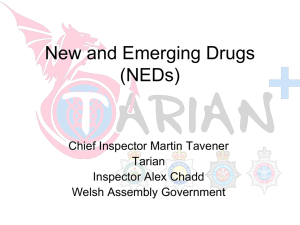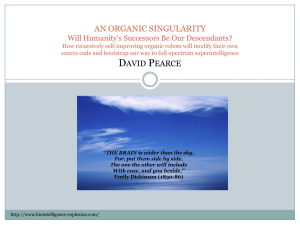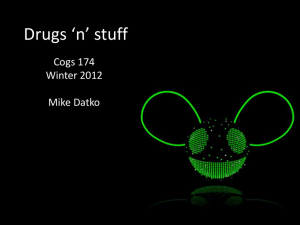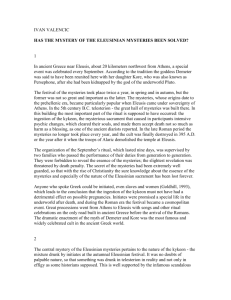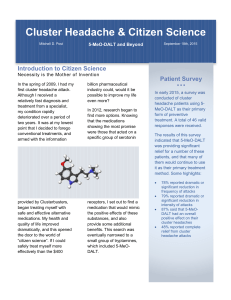Alexander Shulgin *Godfather of Psychedelics*
advertisement
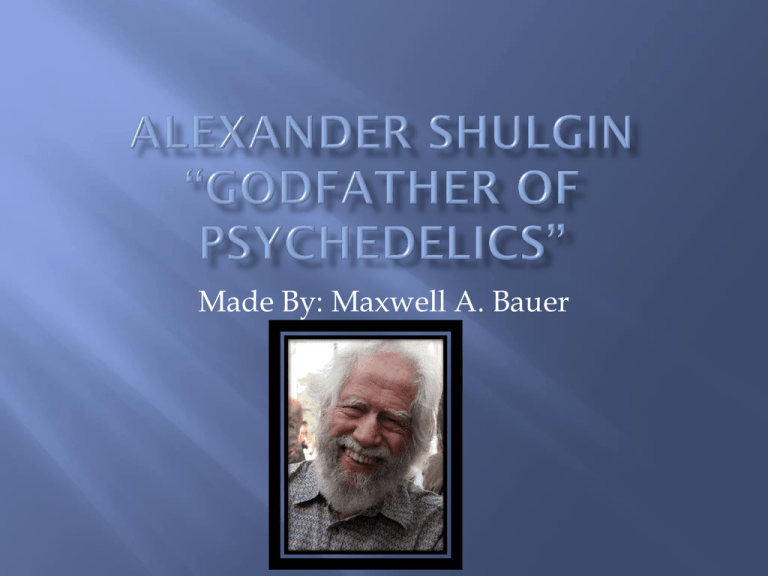
Made By: Maxwell A. Bauer Alexander Theodore Shulgin (also known as Sasha Shulgin by several peers) was born June 17,1925 in America and died June 2, 2014 Medical Chemist, biochemist, pharmacologist, psychopharmocoligist, and author Introduced MDMA , which is commonly referred to as “ecstasy”, to psychologists in the late 1970s for psychopharmacutical usage Shulgin personally synthesized, and bioassayed more than 230 psychoactive compounds, and determined their psychedelic and/or entactogenic potential In 1991 he in addition to his wife Ann Shulgin authored the book PIKAHL (Phenethylamines I Have Known And Loved), which details their work and personal experiences with Phenethylamines Later in 1997 and his wife Ann Shulgin authored another book the book called TIKAHL (Tryntamines I Have Known And Loved), which detailed their work and personal experiences with Tryntamines Shulgin performed seminal work into the descriptive synthesis of many of these compounds. Some of Shulgin's noteworthy discoveries include compounds of the 2C*Family (such as 2C-B) and compounds of the Dox family (such as DOM) Due in part to Shulgin's extensive work in the field of Psychedelic Research and the rational drug design of psychedelic drugs, he has since been dubbed the "godfather of psychedelics" Shulgin was born in Berkeley, California (1893–1978) His parents are Theodore Stevens Shulgin and Henrietta D. (Aten) Shulgin (1894–1960) Alexander began studying organic chemistry as a Harvard University scholarship student at the age of 16 but later in 1943 at only 18 years old, he dropped out of school to join the U.S. Navy The Navy was where Shulgin first took interest in psychoactive drugs. Shulgin while in the navy needed surgery and before receiving it a military nurse gave him a glass of Orange Juice. Shulgin fell asleep quickly so he assumed the OJ was laced with a narcotic. When he learned that no drug had been in his drink he became curious about how placebo’s (inactive substances) affected the mind. Shulgin Navy in World War II, thenreturned to Berkeley, California where he earned a Ph.D. in biochemistry from the University of California, Berkeley Shulgin studied the fields of psychiatry and pharmacology and in the late 1950s he started working at Bio-Rad Laboratories as a research director then began work at Dow Chemical Company as a senior research chemist During this time he had a series of psychedelic experiences that helped to shape his further goals and research, the first experience being induced by mescaline Alexander has recalled this experience saying that the use of the drug helped him understand what was inside of him. Shulgin later talked about some of his personal revelations that "had been brought about by a fraction of a gram of a white solid, but that in no way whatsoever could it be argued that these memories had been contained within the white solid ... I understood that our entire universe is contained in the mind and the spirit. We may choose not to find access to it, we may even deny its existence, but it is indeed there inside us, and there are chemicals that can catalyze its availability" Shulgin continued to be curious about psychoactives both in terms of his career at the time as well as his own personal experiences with psychedelics. However at the time he was unable to further pursue this interest He developed Zectran, the first biodegradable pesticide which became highly profitable product. He was employed at Dow Chemical, where he was permitted to explore other areas in biochemistry and pharmacology In PIHKAL, Shulgin limits his pesticide days at Dow Chemical to one sentence in 978 pages. 1966, Shulgin left Dow so he could further research his interests. He first spent two years studying neurology at the University of California, San Francisco School of Medicine, but later left in order to work on a consulting project Following this he built his a home-based lab on his property which he referred to as “The Farm", and became a private consultant. In addition to this he also taught classes at local universities as well as at San Francisco General Hospital. Through his friend Bob Sager, head of the U.S. DEA's Western Laboratories, Shulgin managed to maintain a relationship with the DEA and began holding pharmacology seminars for DEA agents, even going so far as to supply the DEA with samples of many compounds, and occasionally serving as an expert witness in court In the year1988, he authored the official law enforcement reference book on controlled substances. For this he received several awards from the DEA Shulgin obtained a DEA Schedule I license for an analytical laboratory, which allowed him to synthesize and possess any otherwise illicit drug so he could work with scheduled psychoactive chemicals Shulgin then helped build a chemical synthesis laboratory in a small building behind his house thus giving him freedom to synthesize and test the effects of potentially psychoactive drugs In 1976, a student in the medicinal chemistry group he advised at San Francisco State University introduced him to MDMA otherwise known as “ecstasy” MDMA had been synthesized in 1912 by Merck and patented the same year, however though he nor anyone else thoroughly researched the drug Shulgin proceeded to create his own personal synthesis method In 1976 Shulgin showed Leo Zeff the MDMA he had synthesized Zeff applied the chemical in his work to help in talk therapy. Zeff then showed the chemical to many psychologists and lay therapists all over This included Ann Shulgin, Alexander Shulgin's wife whom he would later meet in 1979, and marry in 1981 Shulgin experimented many of the drugs on himself before later getting together a group of friends whom would with him test his psychoactives In 1960 Shulgin and his group created a more standard way of ranking the many various effects of the chemicals, later named the Shulgin Rating Scale, It included a vast vocabulary to describe the visual, auditory and physical sensations of almost any of the drugs affects Shulgin himself tested hundreds of drugs, mainly analogues of various phenethylamines (family containing MDMA, mescaline, and the 2C* family), and tryptamines (family containing DMT, psilocin, and LSD) Shulgin found that even the slightest chemical variation could have radically different results from a similar chemical providing an unlimited supply of result some pleasant others unpleasant Shulgin found the results also heavily depended on the person, substance and situation. So in order to further research this Shulgin wrote down all of his experiences and those of the members of his group. Shulgin published these results sometimes as objective reports and other times as subjective reports in his books and papers In 1994 the DEA raided Shulgin’s lab. They asked Shulgin to turn over his license for violating it’s terms. They then fined him $25,000 for the possession of anonymous samples sent to him for quality testing The DEA stated that, “It is our opinion that those books are pretty much cookbooks on how to make illegal drugs. Agents tell me that in clandestine labs that they have raided, they have found copies of those books” Prior to his 2010 health issues, Shulgin had been working on a series of Nallylated tryptamines including 5-MeO-DALT and 5-MeO-MALT In his later years Shulgin lived on The Farm in Lafayette, California April 8, 2008, at 82, Shulgin had surgery to replace a defective aortic valve He experienced a number of other health issues and then began to show the early signs of dementia, mostly severe loss of short-term memory Over time the dementia progressed and his wife Ann Shulgin tried to sell part of their property to raise more money to cover care costs April 17, 2014, Ann Shulgin posted on Facebook that her husband had developed liver cancer indicated that although seeming weak, he seemed to be experiencing his last moments in peace June 2, 2014, Shulgin died at home in bed surrounded by friends and family, at 88 "Alexander ‘Sasha’ Shulgin." ShulginResearchorg. Wordpress, 2014. Web. 24 Feb. 2015. "Erowid Alexander Shulgin Vault." Erowid Alexander Shulgin Vault. Erowid, 1995. Web. 24 Feb. 2015. "ShulginResearch.org." ShulginResearchorg. Shulgin Research Institute, 17 June 2014. Web. 24 Feb. 2015.
